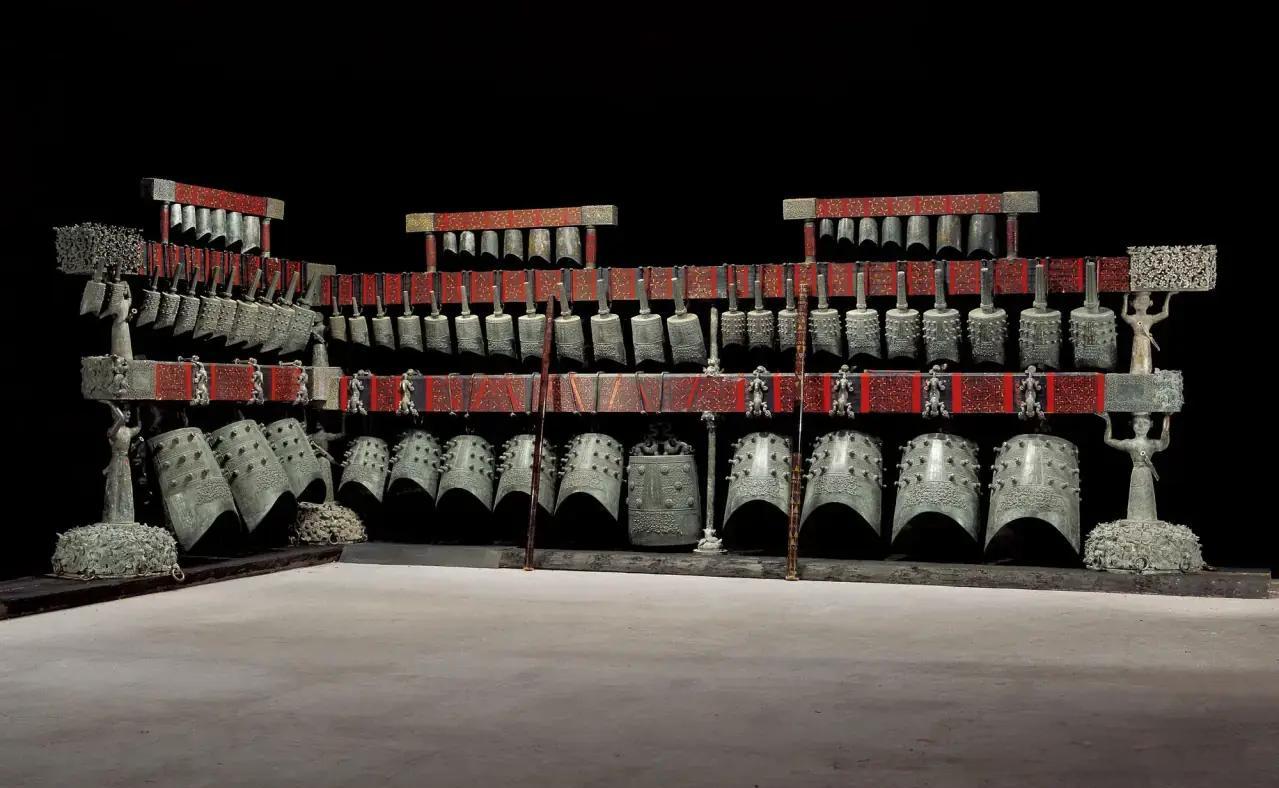Les cloches Zenghouyi: Un chef-d'œuvre intemporel de la Chine ancienne
Introduction à l'artefact
Le Cloches Zenghouyi(Zeng Hou Yi Carillon Cloche), également connu sous le nom de Cloches du Marquis Yi de Zeng, sont l'ensemble de cloches anciennes en bronze le plus grand et le mieux conservé jamais découvert. Découvert dans 1978 du tombeau du marquis Yi de Zeng à Suizhou (anciennement Suixian), Province de Hubei, cet instrument de musique extraordinaire remonte au début de la période des Royaumes combattants (autour 433 avant notre ère). L'ensemble se compose de65 cloches en bronze, disposé danstrois niveaux et huit groupes sur un Porte cloches en bois et bronze en forme de L mesurer 7.48 mètres (24.5 pieds) long, 3.35 mètres (11 pieds) large, et 2.73 mètres (8.96 pieds) haut. L'ensemble pèse un poids étonnant2,567 kilogrammes (5,657 livres), avec la plus grande cloche debout1.52 mètres (5 pieds) grand et pesant 203.6 kilogrammes (449 livres), tandis que le plus petit est juste20.4 centimètres (8 pouces) haut et 2.4 kilogrammes (5.3 livres). Fabriqué à l'aide de techniques avancées telles que fonderie, soudage, incrustation, et embellissement doré, les cloches ne sont pas seulement des chefs-d'œuvre de la métallurgie du bronze, mais elles présentent également des détails complexes.sculptures, gravures, et peintures en laque.
Fonction & Utiliser
Créé à l'origine pourmusique rituelle, cérémonies judiciaires, et divertissement royal, les cloches Zenghouyi étaient un symbole de pouvoir et de sophistication culturelle. Ils pourraient être joués dans ensembles, produireune large gamme de tons—à partir de notes de basse profondes et résonantes (frappé avec des maillets en bois sur les cloches inférieures) effacer, tons aigus mélodiques (joué avec des percuteurs en bambou sur les cloches supérieures). Remarquablement, chaque cloche peut produire deux hauteurs distinctes (une tierce majeure ou mineure à part) selon l'endroit où il est frappé, permettant ungamme chromatique complète de 12 demi-tons, permettre des performances enpentatonique, hexatonique, ou encore des écailles heptatoniques. Ce “une cloche, deux tons” (Une cloche deux tons) la technologie étaitperdu après la dynastie Sui (581–618 CE) et seulement redécouvert avec cette trouvaille, révolutionner notre compréhension de la théorie musicale chinoise ancienne.
Contexte historique
Les cloches portentinscriptions en écriture dorée, y compris le nom de leur propriétaire, Marquis Yi de Zeng, et un31-inscription de caractère sur la plus grande cloche (un ajout ultérieur par le roi de Chu) commémorant sa mort en 433 avant notre ère. Ces inscriptions fournissent documents historiques précieux du Le système de musique rituelle de la dynastie Zhou (Système rituel et musical) et le échanges musicaux entre les états de Chu, Jin, et Qi. Le tombeau lui-même, une partie duLeigudun (Leigudun) complexe funéraire, a été découvert accidentellement dans1977 pendant les travaux de construction et creusé dans 1978, révélant une richesse d'autres trésors, y comprislaque, armes, et une configuration d'orchestre complète.
Préservation & Importance culturelle
Aujourd'hui, les cloches Zenghouyi sont logées dans le Musée provincial du Hubeià Wuhan, où ils restent l'un de ses les artefacts les plus précieux. Reconnu comme unTrésor national de Chine, ils ont été placés sur lepremière liste d'objets interdits aux expositions à l'étranger (2002) pour assurer leur protection. Dans2025, ils étaient inscrits sur leRegistre de la Mémoire du monde de l'UNESCO, les honorant en tant quele plus ancien manuscrit musical connu au monde inscrit sur des cloches en bronze. Leur découverteréécrit l'histoire de la musique, prouvant queLa Chine possédait un système de tempérament égal à 12 tons entièrement développé 2,000 des années avant l'Occident.
Valeur & Héritage
Les cloches Zenghouyi sont pas seulement des instruments de musique, ils témoignent de l'éclat de l'ancienne civilisation chinoise. Ils mettent en valeur:
✔ Techniques avancées de coulée du bronze (précision dans les ratios d'alliage, unique “cloche composite” conception).
✔ Théorie musicale sophistiquée (première documentation connue sur les systèmes de réglage).
✔ Diplomatie culturelle (l'inclusion d'une cloche de la dynastie Chu comme cadeau diplomatique).
✔ Merveille d'ingénierie (le porte-cloches, soutenu par des statues de guerriers en bronze, existe depuis plus de deux millénaires).
Une invitation chaleureuse
Si jamais vous visitezWuhan, Chine, un voyage vers leMusée provincial du Hubei voir les cloches de Zenghouyi est un incontournable. Debout devant ces2,400-cloches d'un an, vous entendrez non seulement des échos de mélodies anciennes, mais vous serez également témoin dusommet de l’artisanat et du génie musical de l’âge du bronze en Chine. Bienvenue dans le monde du Marquis Yi, un monde où histoire, science, et l'art s'harmonisent en parfaite résonance.
“Quand ces cloches chantent, ils racontent des histoires d'empereurs, érudits, et artisans dont l'héritage vibre encore aujourd'hui.”
